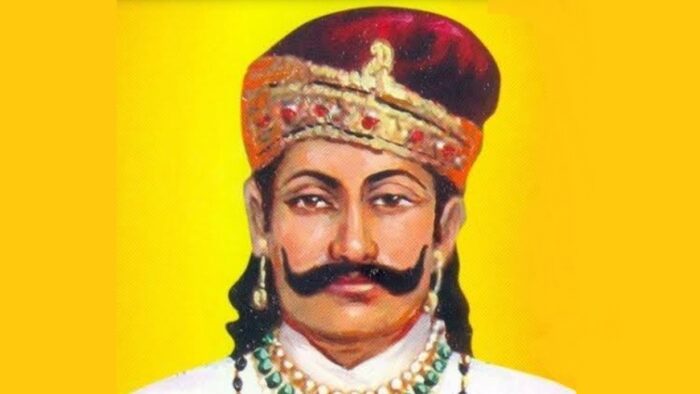1. Introduction to Gāhaḍavāla Dynasty
1.1 Gāhaḍavāla or Gahaḍavāla Vaṃśa (गाहडवाल or गहडवाल वंश) is the dynastic name which appears in the inscriptions of this dynasty. Sarnath inscription1 uses the phrase “गहडवाले क्षत्रवंशे”, i.e., “in the Kṣatra vaṃśa of Gahaḍavāla”, thus indicating the Kṣatriya origin of this dynasty. The Kṣatriya origin is also corroborated by Chandrāvatī inscriptions2 of VS 1150 (1092-93 CE) & VS 1156 (1098-99 CE) that describe the glory of the Gāhaḍavāla dynasty which occupied Kanyakubja and that it belonged to the Kṣātra lineage (“क्षात्रोऽयमत्र वहुपत्रचक्ररथानुगम्यानोन्नतिः विजयते भुवि नृपवंशः”).
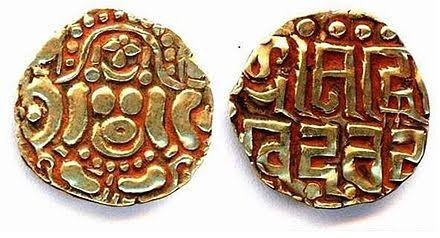
(Coin of Gahaḍavāla King Govindachandra)3
1.2 The Gāhaḍavāla dynasty played a noteworthy role in shaping the history of the upper Gangetic region at a very crucial juncture. The Antarvedī or the Gangā-Yamunā doāb after the decline of the Harṣavardhana and Imperial Pratihāras in the northern region fell an easy prey not only to the Paramāras and Kalachurī dynasties but also the later Yamīnī kings after the death of Sultan Mahmud in 1030 CE. These later Muslim raids were directed against mainly the Doāb. Though the Muslim raiders were being gradually weakened by the internal feuds and foreign invasions, their military operations against the region were not effectively checked till the rise of Gahaḍavāla dynasty at Vārāṇasī and Kanyakubja sometime before 1089 CE.4
1.3 The genealogical lists in Gāhaḍavāla grants trace their origin to Yaśovigraha, who is said to have come to this earth when the kings of the solar race had gone to heaven. This statement may contain a hint that Yaśovigraha flourished after the downfall of the Imperial Pratihāra kings, who traced their descent from the sun. The Rahan grant seems to indicate that the Gāhaḍavālas flourished when the two great regal families, sprung from the Moon and the Sun, had perished. The Solar and Lunar families may be the Imperial Pratihāras and Kalachurīs of Tripuri respectively.5
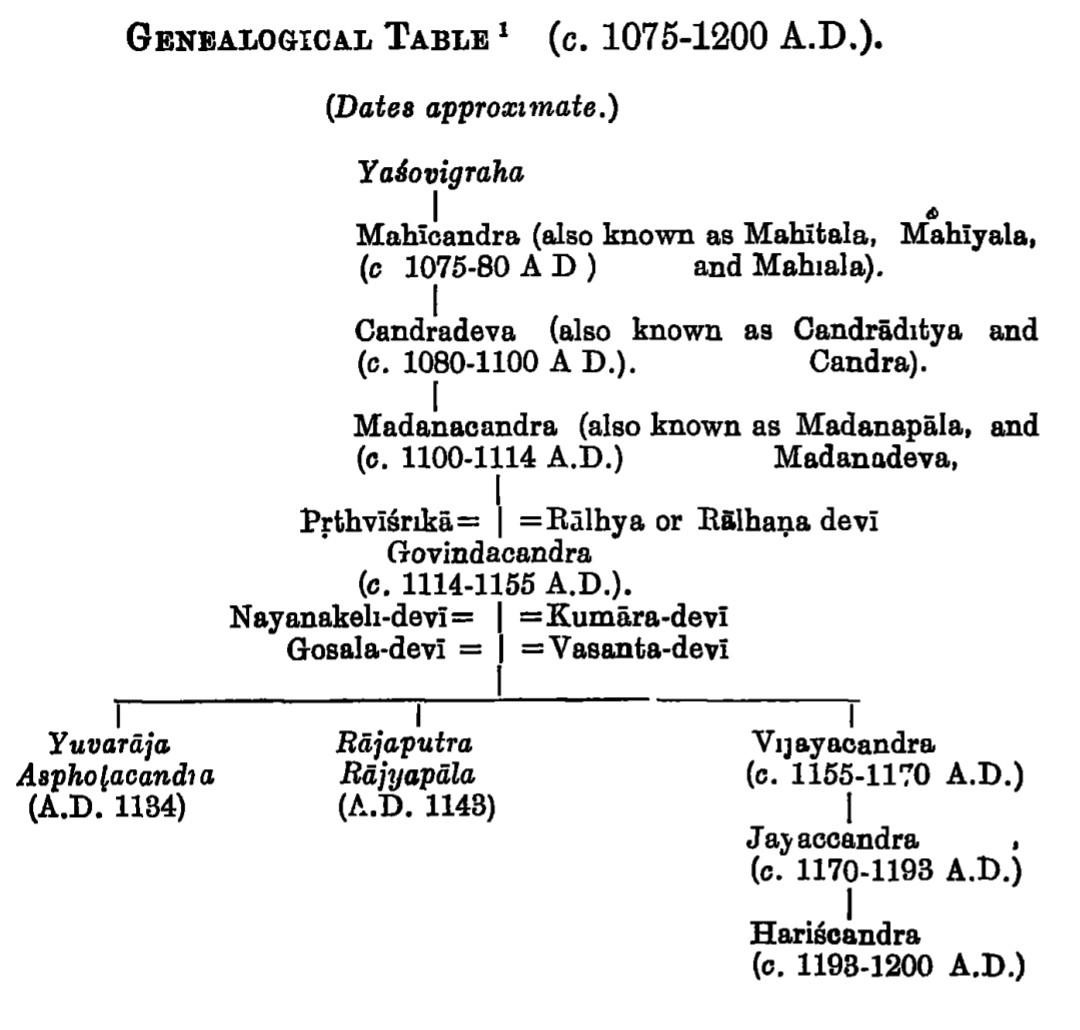
(Genealogical Table of Gahaḍavālas)6
The genealogical table above tells us that Yaśovigraha had a son named Mahichandra, whose son was Chandradeva. A śloka in the Basahi inscription (1104 CE) mentions that after the death of Bhoja and the destruction of Karna’s fame, when the earth became distressed, king Chandradeva acted as the saviour.7 From the copper grants of his descendants, it appears that Chandradeva made Kannauj his capital, and put down the anarchy resulting from the deaths of Rājā Bhoja of the Paramāra dynasty of Malwa and Lakṣmī-Karṇa of the Kalachurī dynasty.8 The districts of Kāśī, Kuśika (Kannauj), northern Kośala (Oudh), and Indrasthānīyaka (Delhi) were under his sway.9
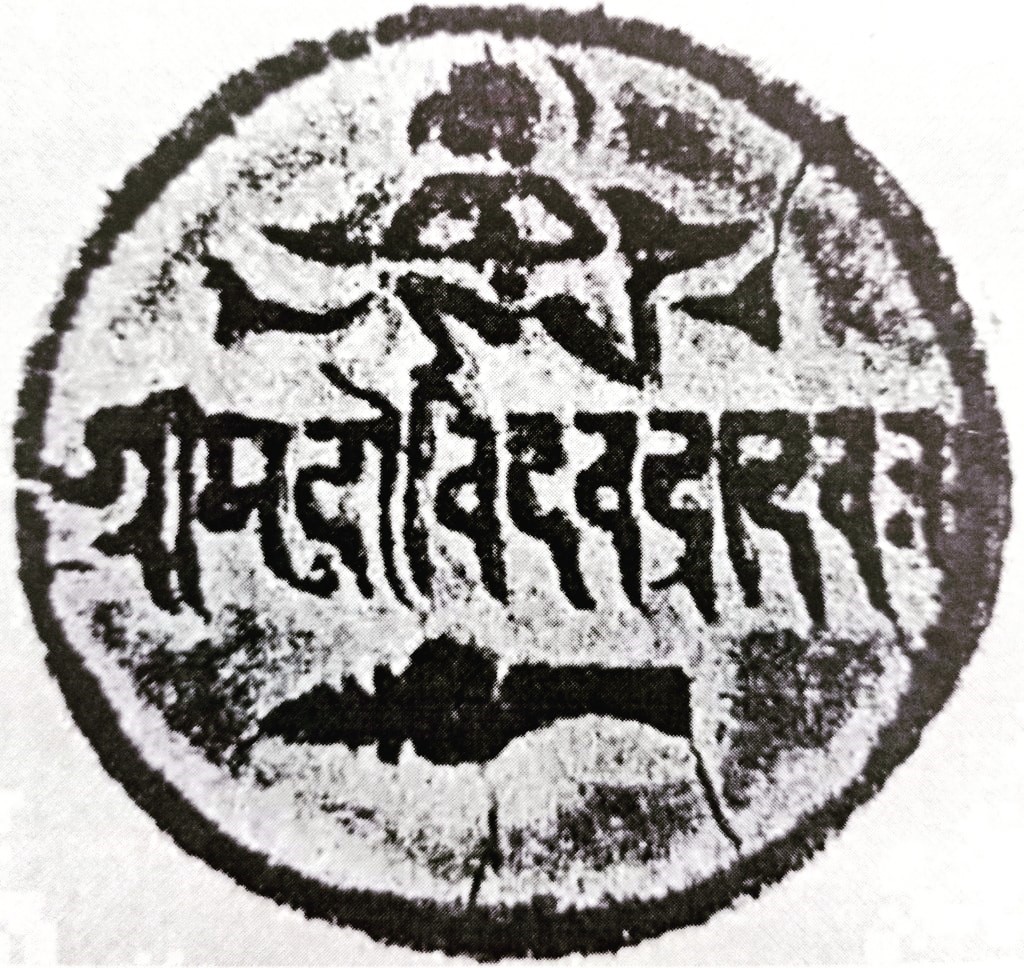
(Seal of Govindachandra found along with Badera inscription, 1114 CE)10
Chandradeva was succeeded by his son Madanachandra, whose son was Govindachandra. Govindachandra seems to have wielded substantial power in the state while he was only a yuvarāja or crown-prince. He defeated the invading bands of Muslims sometime before 1109 CE, for the Rahan plate records that he again and again by the play of his matchless fighting compelled the Hammīra (i.e., Amir) to lay aside his enmity.11 We find a vast number of the copper plate grants of King Govindachandra indicating that he was a powerful and generous ruler and most probably, in his times, was the greatest king in Northern India. He waged successful wars against the Gauḍa prince and Hammira (Muslim Amir) during his father’s reign. The conflicts with the Muslims probably continued even during his reign, for the Sarnath inscription of Kumāradevi tells us that “Hari, who had been commissioned by Hara to protect Vārāṇasī from the wicked Turuṣka warrior, as the only one who was able to protect the Earth, was again born from him, his name being renowned as Govindapāla i.e. Govindachandra.12
Govindachandra was succeeded by his son Vijayachandra who is said to have defeated a Hammira (Amir) in an inscription13 dated 1168 CE: “He swept away the affliction of the globe by the streams (of water flowing as) from clouds from the eyes of the wives of Hammira, the abode of wanton destruction to the earth.”
Hence we conclude that Gāhaḍavāla dynasty had a glorious history of fighting with the Muslim invaders and they successfully prevented the Antarvedī region from the Muslim raids. Moreover, from the inscriptions of Gahaḍavālas, we find that a tax was levied in their kingdom called Turuṣkadaṇḍa to meet the requirements for the war with Turuṣkas (Muslim invaders).14 Jayachandra continued the legacy of his ancestors to fight against Turuṣkas as will be corroborated in the article.
2. Inscriptions and other evidences describing the reign of Jayachandra.
2.1 Vijayachandra was succeeded by his son Jayachandra in 1170 CE.15 Kamauli inscription informs that on the 6th tithi of the bright half of the month of Āṣādha of the Vikram Samvat 1226 (Sunday, the 21st June, 1170 CE), while encamped in the village of Vadaviha, after performing the mantra-snāna at his rājya-abhiṣeka, granted the village of Osia in the Bṛhadgṛhokamisāra Pattalā to the royal preceptor, the Mahāpurohita Prahlāda Śarman.16
Rājaśekharasūri in Prabandha Kośa and Nayachandrasūri in Rambhāmañjarī, record Jayachandra’s name as Jayantachandra and Jaitrachandra respectively. Merutuṅga in Prabandha Chintāmaṇi calls him Jayachandra. In the Purātana Prabandha-saṅgraha, Jayachandra and Jaitrachandra both names occur.
Jayachandra was given this name on account of his grandfather Govindachandra having achieved a victory over the Daśārna country on the very day of his birth. According to Merutuṅga and Nayachandra, Jayacandra bore the epithet of ‘Paṅgu’ or ‘Dala Paṅgula’ from the circumstances that he maintained stupendous forces.17 Jayachandra on account of his inability to hold his sea-like army is known as Paṅgu (poetic expression to indicate a large army), the army which inflicted misery upon the kings between the two branches of the Gaṅgā and the Yamunā.18 The Muslim historians also were considerably impressed by the size of the army which the Rai of Banaras (Jayachandra) possessed; according to the Taj-ul-Ma’asir, a contemporary account, Jayachandra prided himself on the number of his forces and elephants and had an army countless as the particles of sand.19
2.2 There are plenty of inscriptions issued by Jayachandra but not many details of Jayachandra’s career are known from inscriptions, for the copper plate inscriptions contain little historical information beyond recording the usual gifts to the Brāhmaṇas.20 The inscriptions of Jayachandra bear dates ranging from 1170 to 1189 CE. They prove that his kingdom included the Gayā District besides the Doāb, Allahabad, Banaras and Patna. The Gayā District is known to have been ruled by Govindapāla (of Pāla Dynasty) upto 1162 CE. Probably in his attempt to extend the boundary of his kingdom further east, Jayachandra was opposed by Lakṣmaṇa-sena of Bengal.21
The Gahaḍavālas made advance into Bihar in the time of Jayachandra. An inscription dated in VS 1232 (1175 CE) has been found at Sivhar located in the Patna district. It belongs to the time of Jayachandra who made grants of villages in Saranda, Anayi and Māṇar (Maner) paṭṭalā. Jayachandra’s forces reached up to Bodh Gaya as the Bodh Gaya stone inscription dated in VS 1242, i.e., 1185 CE records the construction of a cave in Jayapura and refers to Śrīmitra as the dīkṣā-guru of Jayachandra, king of Kāśī.22
Alois Anton Führer had mentioned an inscription he found at the Treta ka Thakur (Ayodhya), in his “The Sharqi Architecture of Jaunpur”-
“Inscription No. XLIV is written in twenty incomplete lines on a white sandstone, broken off at either end, and split in two parts in the middle. It is dated VS 1241 or 1184 CE, in the time of Jayachandra of Kannauj, whose praises it records for erecting a Vaiṣṇava temple, from whence this stone was originally brought and appropriated by Aurangzeb in building his masjid known as Treta ka Thakur. The original slab was discovered in the ruins of this Masjid, and is now in the Faizabad local Museum.”
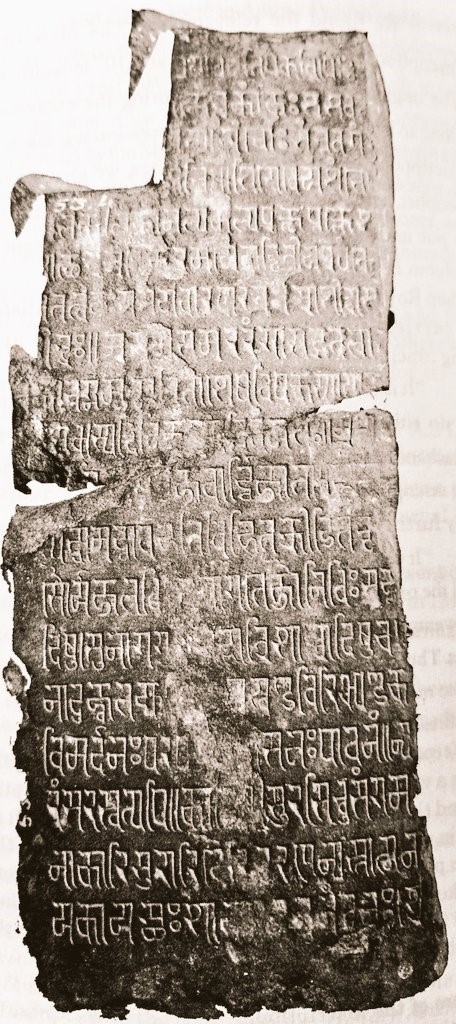
(Treta ka Thakur inscription discovered by A. Fuhrer)23
Führer described the inscription again in “The Monumental Antiquities And Inscriptions In The North-Western Provinces And Audh”-
“A fragmentary inscription of Jayachandra of Kannauj, dated samvat 1241, and recording the erection of temple of Vishnu was rescued from the ruins of Aurangzeb’s Masjid, known as Treta-ka-Thakur, and is now in the Faizabad Museum“.24
Thus, it is clear that A. Fuhrer found this inscription at Ayodhyā in the debris of the Treta Ka Thakur temple, converted into a mosque by Aurangzeb. This inscription coupled with Viṣṇu Hari inscription of Govindachandra (Jayachandra’s grandfather) played an important role in Ram-Janmabhoomi case.
Viṣṇu Hari inscription was discovered allegedly from the ruins of the Babri Masjid, Ayodhya, when it was destroyed on 6 December 1992. Those who were in control of the site at the time took it out, and it is stated that it was lodged at the Rāma Kathā Kunja.25
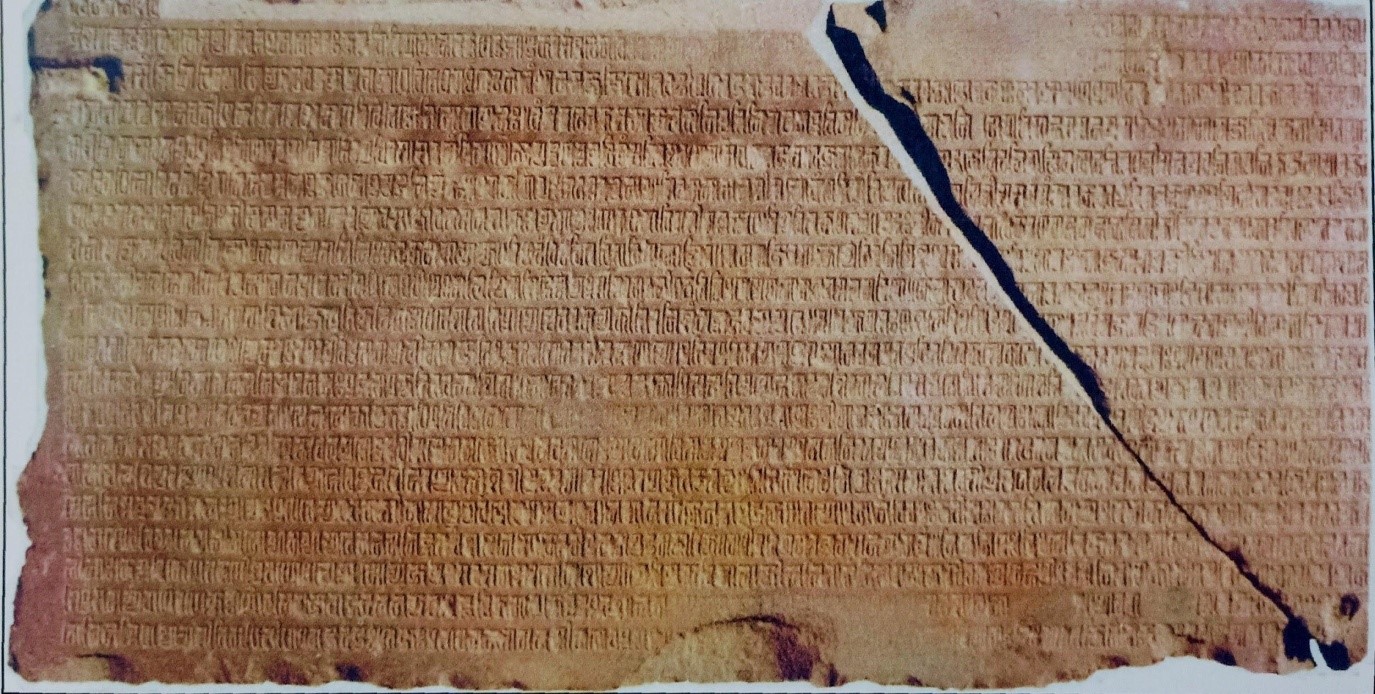
(Viṣṇu Hari Inscription giving the details of regarding the construction of Viṣṇu Hari Temple)26
The Viṣṇu Hari inscription mentions: “Anayachandra earned the lordship of Saketa mandala through the grace of his elder, the lord of earth Govindachandra (grandfather of Jayachandra)… He (Anayachandra) caused the construction of the beautiful temple of Viṣṇu-Hari using large quantity of stones, brought after chiseling from large peaks of mountains and decorated it with a golden pinnacle“.27
Next we come across an interesting information contained in Bodhgaya Inscription. This inscription is of importance as it throws a further light on the religion of the Gāhaḍavāla king Jayachandra-deva (1170-1194 CE), regarding whom it discloses that he was a disciple of this Buddhist monk Śrīmitra.28 We are also informed by a Kamauli grant of Vijayacandra that Jayaccandra was initiated as a worshipper of Śrī Kṛṣṇa on the day of his installation as Yuvarāja.29
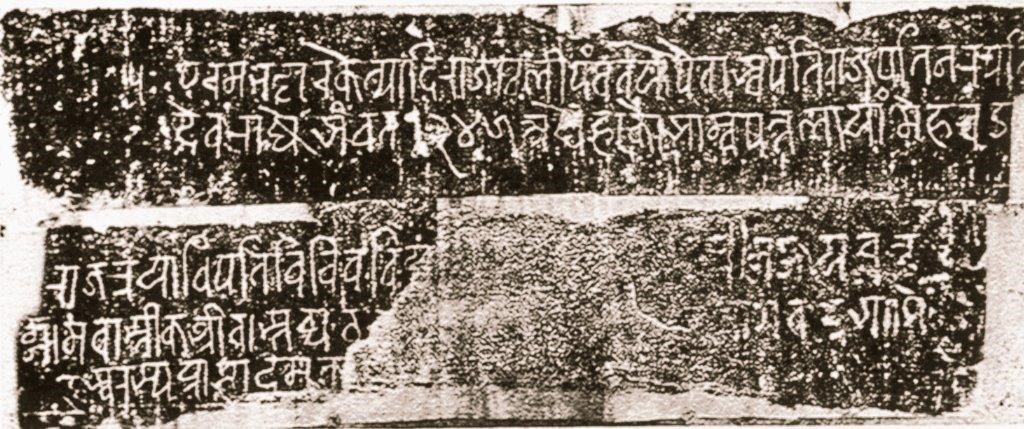
(Meohad inscription, 1189 CE)30
Jayachandra in Meohad inscription (1189 CE)31 is equipped with the five royal titles beginning with a) Paramabhaṭṭāraka; b) one who is the chief of the three classes of rulers, i.e., the Aśvapati, the Gajapati, and the Narapati; and c) Vāchaspati in discussing the different vidyās. This epigraph records that in the year VS 1245 (1189 CE), in the reign of King Jayachandra (of Kannauj), a certain Śrīvāstavya ṭhakkura built a temple of Siddheśvara (Mahādeva) in the village of Mehavaḍa in the district of Kauśāmbī. This village still exists in the vicinity of Kosam and is known by its ancient name.
Kamauli grant (1175 CE)32 of Jayachandra used the title of Paramabhaṭṭāraka Mahārajadhiraja Parameśvara. The Inscription mentions that after bathing in the Gaṅgā at Kāśi, at the Jātakarman (or birth-ceremony when the navel-string is divided) of Jayachandra’s son Hariśchandra, he (Jayachandra) granted the village of Vadesara in the Kaṅgali-Pattalā to the Purohita Praharāja Śarman.
Benares College grant (1175 CE) records Jayachandra, after bathing in the Gaṅgā at Vārāṇasī, on the occasion of Nāma-karṇa (name-giving) ceremony of his son, Rājaputra Hariśchandra, granted two villages in the Māṇara-Pattalā, to the Mahāpaṇdita Hrṣikeśa Śarman.33
Another Kamauli grant (1174 CE)34 of Jayachandra mentions that after bathing in the Gaṅgā at Kāśi, and when he had made tulāpuruṣa mahādāna in the presence of Bhagavān Krittivāsa (Śiva), he granted the village of Khāmbhamaua to nine Brāhmaṇas.
Bestowal of gifts on gods and Brāhmaṇas was a pious act according to the Śāstras. Numerous inscriptions/grants of Jayachandra prove his munificence in these directions. He was a powerful king who made Brahmadāna-s and Mahādāna-s in accordance with Dharmaśāstras.
2.3 Within half a century of the death of Mahmud Ghaznavi, the Gāhaḍavālas had initiated a major building programme at Ayodhyā. Among the temples they built were the Chandra Hari, Viṣṇu Hari, and Dharma Hari temples. Govindachandra had also sponsored a massive fourteen-volume compendium of social/religious codes of conduct, the Kṛtyakalpataru, in recognition of the need “for special reaffirmation of dharma”.35
The local traditions of Jaunpur and Zafarabad connect the names of the next two kings, Vijayachandra and Jayachandra with the construction of a number of temples in the locality. The Ataladevi Masjid in the town of Jaunpur, according to local traditions, was originally a temple of Ataladevi erected by Vijayachandra. After the Muslim conquest of Northern India, it was converted into a mosque some time before 1407 CE. Two other temples are said to have been erected by Vijayachandra and Jayachandra respectively on the sites where the Khalis Mukhelis and the Jhanjira Masjid are now situated; the tradition says that the old temples were demolished under the governorship of Ibrahim and new Islamic structures were set up on their sites. The Lal-Darwaza Masjid is essentially of Hindu design and contains an inscribed stone slab, mentioning the name of Vijayachandra with a date. Another mosque, the Mosque Sheikh Baran, also seems to be of Hindu design and according to some, may have originally formed part of a temple built by Vijayachandra or Jayachandra.36
The Taj-ul-Ma’asir, a contemporary work, claims that after the defeat of Jayachandra, the Turkish soldiers destroyed at Banaras alone “nearly one thousand temples and raised mosques on their foundations”.37 These claims of destructions, although exaggerated, prove that Gāhaḍavāla built a large number of temples in their Kingdom.
2.4 Jayachandra is famous in the literary world as the patron of Śrī Harṣa, the author of the Naiṣadhīya Charita.38 In the conclusion of “Naiṣadhīya Charita” it is stated: “ताम्बूलद्वयमासनं च लभते यः कान्यकुब्जेश्वरात्”, i.e., in the court of the king of Kannauj, Śrī Harṣa had the privilege of being seated on an “Āsana” and of being honoured with the offer of a betel on attending and leaving the court. Though there is no mention of Jayachandra in “Naiṣadhīya Charita”, but from “Prabandha Kośa” compiled by Rājaśekhara Sūri, in VS 1405, we learn that this poet flourished in the court of Jayachandra.39 Thus, Jayachandra patronised Śrī Harṣa, who in his court composed Naiṣadhīya Charita which is regarded as one of the five Mahākāvyas of Sanskrit literature.
3. Ghurid Invasion, Pṛthvīrāja and Jayachandra
In this section, we shall describe the details of Ghurid invasion on Gāhaḍavāla Kingdom, both, from Indic and Persian sources. It is generally assumed in public that Jayachandra invited Ghurids to attack the Chauhans. But the contemporary evidences suggest that it’s untrue.
3.1 Delhi fell in 1192-93 CE, as also did the fortress of Kol in the Aligarh district. These victories of the Muslims prepared the way for their attack on Kannauj, the overthrow of which city had now become necessary, if they were to obtain a firm control over Hindustan. In 590 Hijri or 1194 CE, therefore, Shabuddin marched against Jayachandra with a huge force of “50,000 mounted men clad in armour and coats of mail” according to the Taj-ul-Ma’asir.40 The account of Ghurids’ expedition is given in many Muhammadan histories but only three of them deserve our credence for they were written almost at the time of the event. They are: a) Taj-ul-Ma’asir; b) Kamil-ut-tawarikh; c) Tabaqat-i-Nasiri.41 Hence, we shall look how the Persian sources describe the confrontation of Jayachandra and Ghurids.
Taj-ul-Ma’asir
The Taj-ul-Ma’asir was commenced in the year 602 H. (1205 CE), in the eighth month of which (Shabuddin) Muhammad Ghori died.42 The text describes Ghori’s confrontation with Jayachandra:
“The Rai of Benares, Jayachand, the chief of idolatry and perdition, advanced to oppose the royal troops with an army, countless as the particles of sand, and the noise of the war drum proclaimed to the ears of the worshippers of one God, aid comes from the Almighty, and the sound of the silver kettle-drum and the blast of the brazen trumpets resounded to heaven… The Rai of Benares (Jayachandra), who prided himself on the number of his forces and war elephants, seated on a lofty howdah, received a deadly wound from an arrow, and fell from his exalted seat to the earth. His head was carried on the point of a spear to the commander, and his body was thrown to the dust of contempt. The impurities of idolatry were purged by the water of the sword from that land, and the country of Hind was freed from vice and superstition“.43
Kamil-ut-tawarikh
Kamil-ut-tawarikh was completed in the year 1230 CE44. It also mentions about the confrontation between Ghurids and Gāhaḍavālas:
“The king of Benares was the greatest king in India, and possessed the largest territory, extending lengthwise from the borders of China to the province of Malwa, and in breadth from the sea to within ten days’ journey of Lahore. When he was informed of this inroad, he collected his forces, and in the year 590 (1194 A.D.), he entered the territories of the Muhammadans. Shahabu-d din Ghorí marched forth to oppose him, and the two armies met on the river Jumna, which is a river about as large as the Tigris at Músal. The Hindu prince had seven hundred elephants, and his men were said to amount to a million. There were many nobles in his army… When the two armies met there was great carnage; the infidels were sustained by their numbers, the Musalmans by their courage, but in the end the infidels fled, and the faithful were victorious“.45
Tabaqat-i-Nasiri
Tabaqat-i-Nasiri was completed in 1260 CE.46 It says that: “in A.H. 590 (1194 CE), Kutubuddin and Izz’n-d din Husain Kharmil, both being generals of the army, accompanied the Sultan and defeated Raí Jayachand of Benares in the neighbourhood of Chandawal“.47
In all these contemporary Persian accounts, Jayachandra is seen as a powerful Hindu monarch who fought against the Ghurid forces at Chandawal (1194 CE). The exaggerated contempt of Jayachandra is testimony to the fact that Jayachandra was deeply hated by Ghurids and is projected as an enemy of Islam. Hence, we can conclude from these three contemporary Persian accounts that Jayachandra never invited Ghurids to attack Chauhans, in fact, he died fighting on the battlefield against Ghurids, protecting his motherland.
3.2 Now we shall look at some Indic sources talking about Pṛthvīrāja and Jayachandra.
Hammīra Mahākāvya was composed by a Jain author, Nayachandra Sūri, perhaps around 1400 CE.48 In this narrative, the kings of the western countries approach Prithviraj for relief from the depredations of Shihab-al-Din Muhammad Ghuri, based in Multan. Pṛthvīrāja marches against Shihab-al-Din and captures him, but releases him unharmed seven times in succession. Shihab-al-Din then goes to a neighbouring king (mentioned in the text as Ghaṭaika country) and obtains a fresh army with which he advances on Delhi. Hearing about this from afar, Pṛthvīrāja sets out towards the city with a few followers. Shihab-al-Din bribes the king’s master of the horses and his musicians with many gold coins, and then assaults. Pṛthvīrāja is caught in disarray, nonetheless, and gets on a horse to escape but his treacherous musicians sound the drums and the horse begins to prance around, for it has been trained to do so by the master of the horses.49 Here the treachery occurs not because of Pṛthvīrāja’s or Jayachandra’s misdeeds but because of the greed of Pṛthvīrāja’s Aśvapālaka (Master of horses) and Tūrya-vāhakas (Musicians). Also, we are told in this text that the King of Ghaṭaika country (घटैकदेशीयनृपः)50 helped Ghori by providing him an army composed of various tribes like Kāmbojas, Laṅgāhathas, Bhīmas, Bhillas and Baṅgas51:
“काम्बोजलंगाहथभीमभिल्लबंग-आदि-देश-अधिप”
Virendra Singh Rathore opines in his book51: “Hammīra Mahākāvya complains that Ghaṭaika (Jammu) country’s ruler helped a wrecked up Ghori after the battle that Ghurids had just lost. In Purātana Prabandha Saṅgraha, the Chauhan King was informed that the Jammu King had joined hands with Ghori. Similarly, Raverty cites from the History of Rajahs of Jamun that a deputation of the Jammu King met with retreating Ghori on the bank of the Ravi River. Identification of Ghaṭaika with Jammu can also be made by looking at the tribes which, according to Hammīra Mahākāvya, the Ghaṭaika ruler supplied to Ghori: Kamboja, Langah, Bhilla, etc.”
Hence, we observe that in the entire narration of Hammīra Mahākāvya, there is not even a single mention of Jayachandra. Moreover, it was the treachery of Aśvapālaka (Master of horses), Tūrya-vāhakas (Musicians) and Ghaṭaika ruler, which were responsible for Pṛthvīrāja’s defeat in Hammīra Mahākāvya.
Rambhāmañjarī52 was authored by Nayachandrasūri (same author as that of Hammīra Mahākāvya) in around 1400 CE. Rambhāmañjarī affirms that Jayachandra’s arms were like pillars to tie down the elephant-like goddess of Madanavarman’s royal fortune, which proves that he attacked the Chandella king, the predecessor of Paramardi some time as a prince. But from the context of the Prabandhas it appears that all the attacks were changed in treaties and did not create any bitterness. It also states that Jayachandra had destroyed the Yavanas. This view receives full support by the Puruṣa-parikṣā of Vidyāpati.53 The important thing to observe here is that Nayachandrasūri, in both his works (Hammīra Mahākāvya & Rambhāmañjarī) didn’t mention a single instance of rivalry between Gāhaḍavālas and Chauhans.
Pṛthvīrāja’s downfall, in Prabandha Chintāmaṇi (1304 CE), is precipitated by his mistreatment of a minister, whose ears he has cut off. The wronged minister goes over to the enemy and guides the invading army to Prithviraj’s encampment.55 This again corroborates the statement that Jayachandra had no role in inviting Ghurids against Chauhans.
Some of the Jaina Prabandhas, like Purātana Prabandha Saṅgraha, mention that one of the inveterate enemies of Jayachandra was Chauhan king Pṛthvīrāja, on whose death he felt great joy. The cause of enmity is not mentioned in this prabandha literature.51 But even in this text, Muhammad Ghori was not invited by Jayachandra. It was Pratāpasiṃha (spearman of Pṛthvīrāja), in Puratana Prabandha Saṅgraha, who called upon the Sultan to invade the land of Pṛthvīrāja.56
The following tradition in the Prabandhas accounts for Sihabuddin’s invasion of Gahaḍavāla empire: “A concubine of Jayachandra named Suhavādevī, having got refusal from the king of her son’s claim for the throne and hence being desirous of killing her husband (Jayachandra), she summoned the Mlecchas.”57 This claim doesn’t find any independent corroboration outside Jaina Prabandhas. Moreover, not even a single Persian text (both contemporary and later) mentions any such invitation from Suhavādevī.
3.3 Next we shall analyse the depiction as mentioned in Pṛthvīrāja Rāso.
Pṛthvīrāja Rāso is not a single text but rather a set of texts that have yet to be critically edited. The shortest (laghutam) recension contains approximately 400 stanzas, while the short (laghu) recension is roughly three times longer. Likewise, the medium (madhyam) recension is thrice the length of the short recension, and the long (bṛhad) recension is another threefold longer.58 Namwar Singh concludes that the shortest (laghutam) recension is indisputably older. Only two manuscripts of the shortest (laghutam) recension exist. The one that was obtained from Dharanoj village, Patan taluka, Gujarat, is dated in saṃvat (year) 1667 of the Vikram era or 1610 CE. Its colophon states that it was made for the reading or reciting of Raja Bhagvandas, the son of Raja Bhan, the son of Maharaja Kalyanmalla of Bikaner. The second laghutam manuscript is dated saṃvat 1697 or 1640 CE.59
Laghutam recension of Pṛthvīrāja Rāso has been analysed by Mataprasad Gupta60 in his book titled: “Pṛthvīrāj Rāsau”. In Chapter-12 of this book, he has categorically pointed out that:
“‘आईन-ए-अकबरी के अनुसार शहाबुद्दीन पृथ्वीराज पर किए गए अन्तिम आक्रमण के पूर्व जयचन्द से मैत्री स्थापित करता है । ‘रासो’ में यह नहीं है।”, i.e., In the Ain-i-Akbari (16th century CE), Shabuddin befriended Jayachandra before attacking Pṛthvīrāja. But in Pṛthvīrāja Rāso (laghutam recension) there is no such friendship (between Ghurids and Jayachandra).
Hence, even though Pṛthvīrāja Rāso (laghutam recension) mentioned the rivalry between Jayachandra and Pṛthvīrāja, it never accuses that Jayachandra invited Ghurids. It was Ain-i-Akbari which propagated this myth of Jayachandra joining Ghurids against Chauhans, roughly 400 years after the battle at Tarain. This myth was further re-written in various texts after Ain-i-Akbari. Thus, it was forcefully peddled in the mainstream without any historical basis.
4. Conclusory Remarks
After discussing important historical sources related to Jayachandra, one can safely arrive at the conclusion that he was one of the most generous kings of his time whose inscriptions are filled with land grants to the priestly class. He has been described as having a powerful army to defend his Kingdom (corroborated from both Persian and Indic sources). Jayachandra was famous in the literary world as the patron of Śrī Harṣa, who in his court composed Naiṣadhīya Charita which is regarded as one of the five Mahākāvyas of Sanskrit literature. Traditional and inscriptional references portray him as a builder of temples at Benaras and Ayodhyā.
Moreover, there are no evidences contemporaneous to Pṛthvīrāja and Jayachandra which prove that he invited Ghurids. In fact, even the evidences which hint at rivalry between the two, never accuse Jayachandra of inviting Ghori.
Notes & References
- Epigraphia Indica Vol. IX, 1907-08, p. 324
- Indian Historical Quarterly Vol. XXV, 1949, 32, 36
- Image from Wikimedia: https://upload.wikimedia.org/wikipedia/commons/8/80/Govindchandra.jpg
- Jaya Kakkar, “Strategic significance and architectural magnificence of the fort of Kara”, Journal article in Proceedings of the Indian History Congress, Vol. 78 (2017), p. 1013-1020
- HC Ray, “The Dynastic History of Northern India”, Vol. 1, 1931, p. 506
- p. 548
- Roma Niyogi, “The History of Gahaḍavāla Dynasty”, 1959, p. 43
- Sāhityācharya Pt. Bisheshwar Nath Reu, “Gahaḍavālas of Kanauj from about V.S. 1125 (A.D. 1068) to about V.S. 1280 (A.D. 1223)”, the Journal of the Royal Asiatic Society of Great Britain and Ireland No. 1 (Jan., 1932), p.3
- p. 3
- TP Verma & AK Singh, “Inscriptions of the Gāhaḍavālas and their times”, 2011, Vol. 2, Plate 14
- Ram Shankar Tripathi, “History of Kannauj to the Moslem conquest”, 1937, p. 307
- HC Ray, “The Dynastic History of Northern India”, Vol. 1, 1931, p. 529
- The Indian Antiquary, Vol. XV, 1886, p. 9
- Roma Niyogi, “The History of Gahaḍavāla Dynasty”, 1959, p. 176-181
- p. 102
- HC Ray, “The Dynastic History of Northern India”, Vol. 1, 1931, p. 536
- Gulab Chandra Choudhury, “Political History of Northern India”, 1954, p. 49
- Ram Prakash Poddar, “Nayachandrasūri Rambhāmañjarī”, 1976, p. 14
- Roma Niyogi, “The History of Gahaḍavāla Dynasty”, 1959, p. 109-110
- Ram Shankar Tripathi, “History of Kannauj to the Moslem conquest”, 1937, p. 321
- RC Majumdar, “The struggle for empire”, 1957, p. 54
- Bindeshwari Prasad Sinha, “Dynastic History of Magadha”, 1977, p. 231-232
- Kishore Kunal, “Ayodhya Revisited”, 2016, p. 306
- Meenakshi Jain, “The Battle for Rama”, 2017, p. 110
- Pushpa Prasad, “Three recently found inscriptions at Ayodhya”, Journal article in Proceedings of the Indian History Congress, Vol. 64 (2003), p. 351
- Meenakshi Jain, “Ram and Ayodhya”, 2013, Illustration F.1
- Pushpa Prasad, “Three recently found inscriptions at Ayodhya”, Journal article in Proceedings of the Indian History Congress, Vol. 64 (2003), p. 354
- Indian Historical Quarterly Vol. V, 1929, 19
- p. 20
- Daya Ram Sahni, “Kausambi”, The Journal of the Royal Asiatic Society of Great Britain and Ireland, No. 4 (Oct., 1927), Plate V
- p. 696
- Epigraphia Indica Vol. IV, 1896-97, p. 126
- HC Ray, “The Dynastic History of Northern India”, Vol. 1, 1931, p. 537-538
- Epigraphia Indica Vol. IV, 1896-97, p. 125
- Meenakshi Jain, “The Battle for Rama”, 2017, p. 109
- Roma Niyogi, “The History of Gahaḍavāla Dynasty”, 1959, p. 204-205
- p. 193
- p. 231-232
- Sāhityācharya Pt. Bisheshwar Nath Reu, “Gahaḍavālas of Kanauj from about V.S. 1125 (A.D. 1068) to about V.S. 1280 (A.D. 1223)”, the Journal of the Royal Asiatic Society of Great Britain and Ireland No. 1 (Jan., 1932), p. 16
- Ram Shankar Tripathi, “History of Kannauj to the Moslem conquest”, 1937, p. 328-329
- Indian Historical Quarterly, Vol. V, 1929, 100-101
- Elliot & Dowson, “The History of India as told by its own Historians”, 1869, p. 209
- p. 223
- p. 245
- p. 251
- p. 259
- p. 300
- Cynthia Tablot, “The Last Hindu Emperor Prithviraj Chauhan and the Indian Past, 1200–2000”, 2016, p. 52
- p. 52-53
- Nilkanth Janardan Kirtane, “Hammīra Mahākāvya of Nayachandrasūri”, 1879, Sarga-3, verses 48-49
- Virendra Singh Rathore, “Prithviraj Chauhan – A light on the mist in History”, 2020, p. 116, 118
- Ram Prakash Poddar, “Nayachandrasūri Rambhāmañjarī”, 1976, Introduction gives the details of the author Nayachandrasūri.
- Gulab Chandra Choudhury, “Political History of Northern India”, 1954, p. 49
- Cynthia Tablot, “The Last Hindu Emperor Prithviraj Chauhan and the Indian Past, 1200–2000”, 2016, p. 52
- p. 50
- Gulab Chandra Choudhury, “Political History of Northern India”, 1954, p. 138
- p. 50
- Cynthia Tablot, “The Last Hindu Emperor Prithviraj Chauhan and the Indian Past, 1200–2000”, 2016, p. 282
- p. 283
- Mataprasad Gupta, “Pṛthvīrāj Rāsau”, 1963, p. 147
Disclaimer: The opinions expressed in this article belong to the author. Indic Today is neither responsible nor liable for the accuracy, completeness, suitability, or validity of any information in the article.

